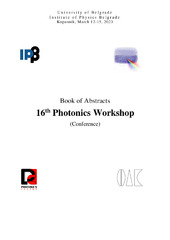| dc.creator | Drvenica, Ivana | |
| dc.creator | Trivanović, Drenka | |
| dc.creator | Radmilović, Mihajlo | |
| dc.creator | Vučetić, Dušan | |
| dc.creator | Krmpot, Aleksandar | |
| dc.creator | Ilić, Vesna | |
| dc.date.accessioned | 2024-01-23T21:55:40Z | |
| dc.date.available | 2024-01-23T21:55:40Z | |
| dc.date.issued | 2023 | |
| dc.identifier.uri | http://rimi.imi.bg.ac.rs/handle/123456789/1405 | |
| dc.description.abstract | Ektacytometry, a diffraction-based method, measures the deformability of entire erythrocyte populations and does not provide information on the altered deformability of individual erythrocytes or affected subpopulation induced by constant oxidative stress, physical stress, metabolic depletion, and loss of ion gradients during their 120 days life span. We introduced an approach based on ektacytometry coupled to flow cytometry analysis to monitor the deformability and heterogeneity of subpopulations of erythrocytes. The effects of in vitro changes of osmotic gradient (from 155 mM to 93 mM phosphate buffer) and treatment by oxidative agent (0.5 mM and 0.75 mM terc-bytil hydroperoxide (TBPH)) on human erythrocyte isolated from healthy male donors, were tested using RheoScan D 300 (RheoMeditech. Inc., Korea) and BD FACSCalibur flow cytometer (Becton Dickinson, USA).
A decrease in erythrocyte deformability by changes in osmolality or treatment with TBPH
per se was demonstrated by ektacytometry. Nevertheless, this method could not analyze the
erythrocytes that underwent both treatments due to their lysis by the shear stress in the
device. The samples of an equal population of normal erythrocytes and erythrocytes
rigidified by 0.5 mM TBPH (slightly rigid) showed elongation indices in the physiological
range, i.e., the effect of the treatments was annulled. The same result was obtained by flow
cytometry. On the other hand, an altered population of oxidized cells by 0.5 mM TBPH was
detected in hypoosmotic 93 mM buffer based on their forward scatter (FSC) (Figure 1) and
side scatter (SSC) parameters. The subtle changes in the erythrocyte’s subpopulation
mechanobiology are essential to monitoring even in healthy people exposed to physical
or/and environmental stress and stored erythrocytes, but some additional techniques are
needed for the established optical-based approaches. | sr |
| dc.language.iso | en | sr |
| dc.publisher | Belgrade: Institute of Physics | sr |
| dc.relation | info:eu-repo/grantAgreement/ScienceFundRS/Promis/6066079/RS// | sr |
| dc.rights | openAccess | sr |
| dc.source | 16th Photonics Workshop, (Conference) Kopaonik, March 12-15, 2023 - Book of Abstracts | sr |
| dc.title | Optical methodologies in the analysis of erythrocyte deformability and heterogeneity | sr |
| dc.type | conferenceObject | sr |
| dc.rights.license | ARR | sr |
| dc.citation.epage | 27 | |
| dc.citation.spage | 27 | |
| dc.identifier.fulltext | http://rimi.imi.bg.ac.rs/bitstream/id/3274/Optical_methodologies_in_the_analysis_of_erythrocyte_deformability_and_heterogeneity.pdf | |
| dc.identifier.rcub | https://hdl.handle.net/21.15107/rcub_rimi_1405 | |
| dc.type.version | publishedVersion | sr |

